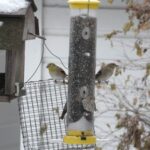The Pink Flamingo is somewhat of an American Icon, being famous as the model for a tacky, yet somewhat charming lawn ornament for several decades. Beyond this, they really are beautiful and fascinating birds – and chances are you don’t know what makes Flamingos pink. (Though the Subtitle “Are Flamingos Pink Because They Eat Shrimp?” should give you a pretty big clue!)
Flamingos are a water bird that are characterized by their S-shaped necks and their habit of standing on only one leg. They commonly live in warm climates and in water areas such as lakes, lagoons, tidal flats, and swamps. A fully grown flamingo is between 3-5 feet tall and typically has a correlating wingspan of similar length. Flamingos are also common birds to house in zoos, conservatories, and other nature preserve areas.
Flamingos are typically born a white or light gray color – so what is it then that makes the Flamingos pink? It is believed that flamingos get their pink coloring from their diet which is high in beta carotene. Flamingos eat mostly shrimp, algae, and other nutrients found in their habitats. Shrimp, insects, algae, and other things they eat contain a pigment known as beta carotene. Beta-carotene is a form of Vitamin A found commonly in several plants, fruits, vegetables, and other organic compounds. It is even available as a dietary supplement in health stores. However, over consumption of beta carotene causes a natural condition called carotenodermia, which basically causes the pigments in one’s skin (or in this case feathers!) to turn a pink-ish orange color.
The good news is that having carotenodermia is generally believed to be a harmless condition, and even some babies and vegetarians may be prone to the condition, since beta carotene is found in many fruits and vegetables that are predominant in their diet. Broccoli, yams, carrots, lettuce, spinach, and even foods such as milk and milk products all have beta carotene in them. For the pink flamingo, turning pink means they are getting all the nourishment and nutrients they need. However, for humans, too much beta carotene for a prolonged period of time may cause problems later down the road. So, if you find yourself turning orange and a doctor has diagnosed you with having carotenodermia, reducing the amount of high beta carotene foods you eat and eliminating vitamin A supplements may be necessary to prevent any complications from having too much beta carotene. Fortunately, the change in skin color due to diet is not permanent, though it may take several weeks or months of reducing beta carotene for one’s skin to turn back to its original color.
Finding out what makes flamingos pink and that they are often pink because of their diet of shrimp and other high beta carotene foods really puts a new meaning to the phrase “you are what you eat!”. However, one would have to eat extremely large quantities of high beta carotene foods or take too much Vitamin A before needing to worry about their skin changing to an orange hue. So, no, you cannot use carotenodermia as an excuse to not eat all of your veggies!
Now that you know what makes flamingos pink, you can enjoy sharing this trivia with family and friends!
Information Sources: Wikipedia, TheJungleStore.com


